Pierwszego bloga założyłem w 2006 roku. Ta jedna decyzja zmieniła wszystko – otworzyła drzwi i ostatecznie doprowadziła mnie do stworzenia WPBeginner, obecnie największej na świecie witryny z darmowymi zasobami WordPress.
Nazywam się Syed Balkhi i przez lata zbudowałem kilka odnoszących sukcesy blogów – niektóre z nich generują obecnie siedmiocyfrowy dochód. Blogowanie całkowicie zmieniło moje życie i wierzę, że może zrobić to samo dla ciebie.
Jeśli myślisz o założeniu bloga, nie musisz sam o tym myśleć. W tym przewodniku przedstawię dokładny proces, z którego korzystam za każdym razem, gdy zakładam nowego bloga. Przeprowadzę Cię przez wszystko krok po kroku.
Otrzymasz również osobiste wskazówki, których nauczyłem się przez lata prawdziwego blogowania – porady, których chciałbym, aby ktoś mi udzielił, gdy dopiero zaczynałem.
Niezależnie od tego, czy chcesz blogować jako kreatywne ujście, dodatkowe zajęcie, czy biznes, ten przewodnik jest twoim punktem wyjścia – i zaczynasz z doświadczeniem odnoszącego sukcesy blogera u boku.
Stwórzmy Twój blog online – i razem zróbmy ten pierwszy krok.
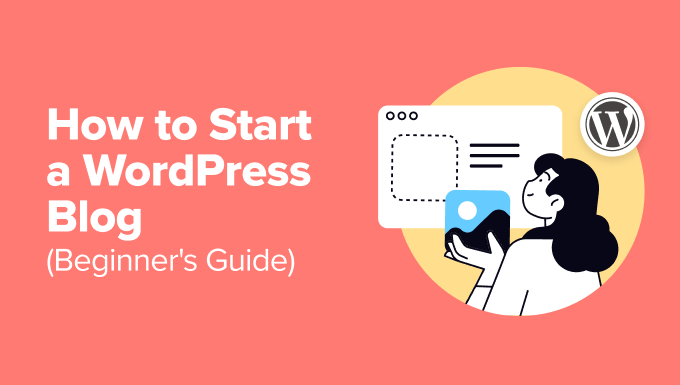
Zamierzasz założyć swojego pierwszego bloga? Obiecuję, że proces ten jest łatwy do wykonania, niezależnie od tego, czy masz 20 czy 60 lat. Jeśli jednak potrzebujesz dodatkowych wskazówek, mój zespół ekspertów pomoże ci skonfigurować twojego bloga za darmo. → Kliknij tutaj, aby uzyskać darmową konfigurację twojego bloga WordPress! ←
Czym jest blog (i dlaczego warto założyć go już dziś)
Zanim przejdziemy do kolejnych kroków, chciałbym poświęcić chwilę na omówienie tego, czym tak naprawdę jest blog – i dlaczego jego założenie może być najlepszą decyzją, jaką podejmiesz w tym roku.
Blog to rodzaj witryny internetowej, na której regularnie publikujesz treści, zazwyczaj w formie artykułów lub aktualizacji. Możesz go używać do dzielenia się swoimi przemyśleniami, uczenia czegoś, opowiadania relacji, recenzowania produktów, a nawet prowadzenia firmy.
Kiedy uruchomiłem swojego pierwszego bloga w 2006 roku, nie do końca zdawałem sobie sprawę z jego wpływu.
Zaczęło się jako sposób na dzielenie się tym, czego się uczyłem, a z czasem otworzyło drzwi, których nigdy się nie spodziewałem – w tym przekształcenie bloga w pełnoetatowy biznes.
Na tym polega piękno blogowania. Nie chodzi tylko o pisanie. To sposób na łączenie się z ludźmi, budowanie czegoś twojego i tworzenie prawdziwych możliwości.
Niezależnie od tego, czy chcesz blogować jako kreatywne ujście, zwiększyć dodatkowy dochód, czy zbudować poważną obecność w Internecie – wszystko zaczyna się w ten sam sposób.
Publikujesz swój pierwszy wpis. Kontynuujesz. I krok po kroku, twój blog zamienia się w coś potężnego. 📈
W kolejnych krokach pokażę ci dokładnie, jak założyłbym bloga dzisiaj – korzystając z tego samego procesu, który zastosowałem, aby uruchomić wiele udanych blogów. Na każdym kroku otrzymasz moje osobiste wskazówki, narzędzia i lekcje.
A co najlepsze? Nie musisz być ekspertem technicznym ani profesjonalnym pisarzem, aby zacząć. Wszystko, czego potrzebujesz, to temat, który Cię interesuje i chęć rozpoczęcia.
- Step 1: Picking the Right Blog Niche
- Step 2: Getting Started With Your Blog
- Step 3. Install WordPress Blogging Software
- Step 4: Customizing Your Blog
- Step 5: Writing Your First Blog Post ✍️
- Step 6: Adding Essential Plugins 🔌
- Step 7: Growing Your Blog Audience
- Step 8: Making Money From Your Blog 💰
- Step 9: Mastering WordPress
- Bonus Tip: Explore Niche Blogging Resources
- Frequently Asked Questions About Blogging (FAQs)
- Video Tutorial
- Final Thoughts
Gotowy? Zaczynajmy.
Masz trudności z założeniem bloga? Usługi WPBeginner Pro mogą sprawić, że twój wymarzony blog stanie się rzeczywistością! Nasi doświadczeni programiści WordPress opracują własny projekt, w tym dostosowaną stronę główną i pięć szablonów podstron – a wszystko to w przystępnej cenie. Skorzystaj z naszych usług projektowania witryn internetowych WordPress już dziś!
Krok 1: Wybór odpowiedniej niszy blogowej
Jedną z pierwszych decyzji, jakie podejmiesz, jest wybór niszy Twojego bloga – głównego tematu, o którym będziesz pisać.
Cały czas dostaję pytanie: “O czym powinienem pisać bloga?”. Moja odpowiedź jest prosta: zacznij od czegoś, na czym ci zależy. Jeśli to cię pasjonuje, będziesz czerpać z tego procesu o wiele więcej przyjemności – a twoi czytelnicy również to odczują.
Kiedy założyłem WPBeginner, skupiłem się na WordPressie. Uwielbiałem pomagać ludziom w jego nauce i to nadało mojemu blogowi jasny kierunek. Ta pasja sprawiła, że nie przestawałem – nawet gdy nie było łatwo.
Twoją niszą może być hobby, nabyta umiejętność, a nawet coś, o czym chcesz dowiedzieć się więcej. Nie czuj, że musisz być ekspertem – po prostu dziel się tym, co wiesz i ucz się dalej.
Jeśli nie jesteś pewien, co wybrać, zadaj sobie pytanie:
- Jakie tematy lubię czytać lub o nich rozmawiać?
- Jakimi doświadczeniami lub umiejętnościami mógłbym podzielić się z innymi?
- Czy jest to coś, o czym mogę pisać regularnie bez znudzenia?
- Czy ten temat może przerodzić się w biznes lub przyciągnąć odbiorców?
Nie martw się o wybranie “idealnej” niszy pierwszego dnia. Najważniejsze jest, aby zacząć od czegoś, co Cię ekscytuje. Zawsze możesz ją udoskonalić w miarę rozwoju twojego bloga.
Wskazówka bonusowa: Mój zespół przygotował listę popularnych nisz na blogi, które zarabiają pieniądze. Jeśli potrzebujesz inspiracji, jest to świetne miejsce do odkrywania pomysłów.
Krok 2: Rozpoczęcie korzystania z bloga
Widziałem wielu użytkowników rozpoczynających swój pierwszy blog na darmowej platformie. Wydaje się to najłatwiejszą opcją w danym momencie, ale nie trwa długo, zanim zostaną uderzeni ograniczeniami.
Nie mogłeś dostosować wyglądu, dodać funkcji, a nawet w pełni posiadać swoich treści.
Tutaj z pomocą przychodzi WordPress.
WordPress dał mi pełną kontrolę. Mogłem rozwijać swoją witrynę, zarabiać na niej w dowolny sposób i budować prawdziwy biznes.
Jest to ta sama platforma, której użyłem do stworzenia WPBeginner i którą polecam każdemu, kto chce założyć bloga we właściwy sposób. Aby uzyskać więcej informacji, zapoznaj się z moją pełną recenzją WordPress.org.
Oto dlaczego polecam rozpoczęcie Twojego bloga z WordPress.org:
- Jest darmowy i open-source
- Nie potrzebujesz umiejętności kodowania
- Jesteś w pełni właścicielem treści i witryny.
- Możesz zarabiać na nim w dowolny sposób
Aby rozpocząć korzystanie z WordPress.org, potrzebujesz tylko trzech rzeczy:
- Nazwa domeny – jest to nazwa Twojego bloga (np. wpbeginner.com).
- Hosting – tutaj przechowywane są pliki Twojego bloga.
- 30 minut twojego czasu – tylko tyle potrzeba, aby uruchomić bloga już dziś.
Nazwa domeny kosztuje zwykle 14,99 USD rocznie, a hosting zaczyna się od około 7,99 USD miesięcznie. To może się sumować – zwłaszcza gdy dopiero zaczynasz.
Dlatego polecam Bluehost – firmę hostingową, z której osobiście korzystam i której ufam.
Bluehost współpracuje z WordPress od 2005 roku i hostuje miliony witryn internetowych. Z Bluehost otrzymasz:
- Niedrogi hosting z bezpłatną nazwą domeny
- Szybkie serwery i duża przestrzeń dyskowa
- Pomoc techniczna 24/7 od ekspertów WordPress.
- Do 83% zniżki przy użyciu mojego kuponu Bluehost
Więcej szczegółów można znaleźć w mojej pełnej recenzji Bluehost.
Jeśli postępujesz zgodnie z tym przewodnikiem i nie możesz uruchomić swojego bloga online w ciągu 30 minut, mój zespół skonfiguruje go dla Ciebie za darmo. Wystarczy skontaktować się z nami, korzystając z naszej bezpłatnej usługi konfiguracji bloga.
ℹ️ UWAGA: Jeśli zarejestrujesz się za pomocą mojego odnośnika, otrzymam niewielką prowizję bez dodatkowych kosztów. W rzeczywistości zaoszczędzisz pieniądze i otrzymasz bezpłatną domenę w ramach umowy.
Aby rozpocząć, otwórz Bluehost w nowej karcie i kliknij zielony przycisk “Rozpocznij teraz”.

Wybierz żądany plan hostingowy. Najpopularniejszymi opcjami są Basic i Choice Plus.
Następnie wybierz swoją nazwę domeny.
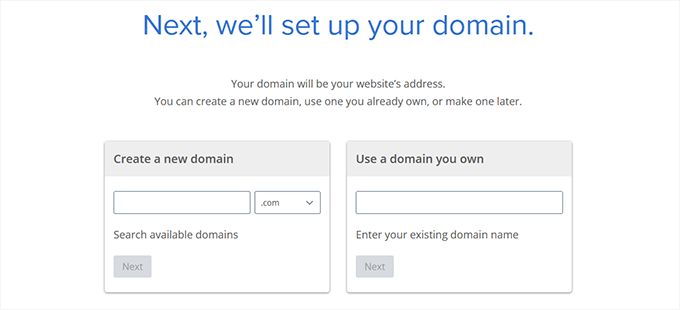
Wypełnij dane swojego konta i sfinalizuj swój pakiet. Zalecam wybranie planu 12-miesięcznego, aby uzyskać najlepszą wartość.
Opcjonalne dodatki są widoczne na stronie kasy. Nie są one teraz potrzebne – w razie potrzeby zawsze można je dodać później.
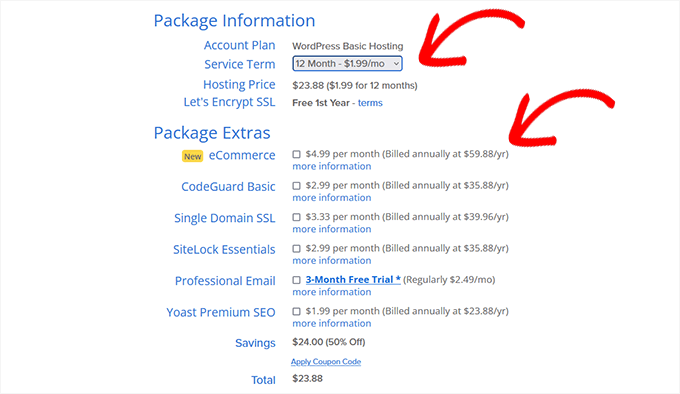
Po zakończeniu zakupu Bluehost prześle e-mailem twoje dane logowania. Będziesz ich używać, aby uzyskać dostęp do panelu sterowania hostingu(zwanego cPanel), w którym będziesz zarządzać witryną i instalować WordPress.
Krok 3. Zainstaluj oprogramowanie do blogowania WordPress
Gdy zarejestrujesz się w Bluehost za pomocą mojego linku, automatycznie zainstalują dla Ciebie WordPress, abyś mógł natychmiast rozpocząć tworzenie swojego bloga.
Wystarczy zalogować się na swoje konto Bluehost, a następnie kliknąć przycisk “Edytuj witrynę”, aby rozpocząć.

Możesz również zalogować się do WordPress, przechodząc do yoursite.com/wp-admin/ bezpośrednio z przeglądarki.
Jeśli korzystasz z innej usługi hostingu blogów WordPress, takiej jak SiteGround, Hostinger, DreamHost lub innych, możesz zapoznać się z moim przewodnikiem na temat instalacji WordPressa, aby uzyskać instrukcje krok po kroku dla tych dostawców.
To powiedziawszy, powiadomienie zauważyłem, że większość z powyższych firm hostingowych blogów teraz automatycznie instaluje WordPressa, aby pomóc nietechnicznym użytkownikom rozpocząć swoją przygodę z blogiem.
Po skonfigurowaniu WordPressa możesz tworzyć strony bloga, dostosowywać jego wygląd i rozpocząć blogowanie.
Krok 4: Konfigurator twojego bloga
Kiedy założyłem swojego pierwszego bloga, spędziłem wiele godzin próbując sprawić, by wyglądał idealnie. Nie byłem najlepszym projektantem, więc eksperymentowałem z różnymi motywami, kolorami i układami.
Na początku wydawało mi się to przytłaczające, ale szybko zdałem sobie sprawę, że prostota jest kluczem do świetnego projektu bloga.
Wygląd bloga jest jak twarz witryny. Jest to pierwsza rzecz, którą zauważają odwiedzający, nadając ton ich doświadczeniom. WordPress ułatwia stworzenie profesjonalnego projektu bez konieczności posiadania umiejętności kodowania.
Motywy WordPress kontrolują wygląd twojego bloga. Kiedy po raz pierwszy zainstalujesz WordPressa, Twój blog będzie wyglądał tak:

Nie martw się, jeśli nie jest to to, co sobie wyobrażałeś. WordPress oferuje tysiące darmowych i premium motywów, które całkowicie odmienią wygląd Twojego bloga.
Aby rozpocząć, przejdź do kokpitu WordPress i kliknij Wygląd ” Motywy. Następnie kliknij przycisk “Dodaj nowy motyw”.
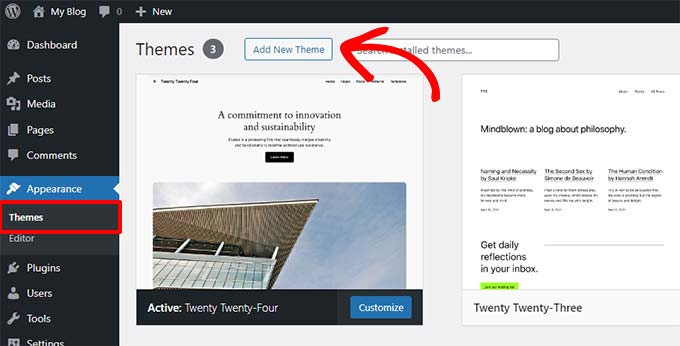
W katalogu WordPress.org znajdziesz ponad 7 000 darmowych szablonów. Możesz filtrować je według popularnych, najnowszych lub określonych funkcji.
Najedź kursorem na motyw, aby wyświetlić podgląd, który pokazuje, jak może on wyglądać w Twojej witrynie.

Pamiętaj, że podgląd nie będzie idealny, dopóki nie dostosujesz go później.
Po znalezieniu odpowiedniego motywu wystarczy kliknąć “Zainstaluj”. Po zainstalowaniu kliknij “Włącz”, aby uruchomić go na twojej witrynie.
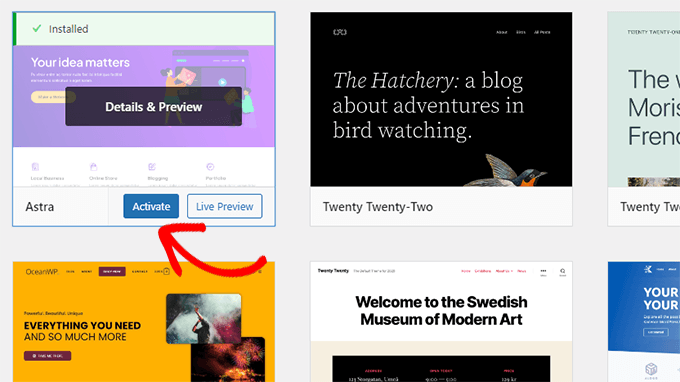
Na początku mojej blogowej podróży zdałem sobie sprawę, że mniej znaczy więcej, jeśli chodzi o design. Czysty, prosty blog nie tylko wygląda lepiej, ale także ułatwia czytelnikom znalezienie tego, czego szukają.
Po aktywowaniu motywu możesz przejść do sekcji Wygląd ” Dostosuj, aby dostosować kolory, czcionki i układy. Możesz nawet dodać swoje logo, aby uczynić swój blog wyjątkowym.
Jeśli korzystasz z motywu blokowego, edytor znajdziesz w sekcji Wygląd ” Edytor.

Aby uzyskać jeszcze większą kontrolę, zalecam użycie kreatora stron, takiego jak SeedProd lub Divi.
Mam SeedProd na wielu moich biznesowych witrynach internetowych i blogach. Dowiedz się więcej na jego temat w mojej szczegółowej recenzji SeedProd.
Narzędzia te nazywane są kreatorami stron i oferują intuicyjne interfejsy typu “przeciągnij i upuść” do tworzenia niestandardowych projektów. Możesz tworzyć niestandardowe nagłówki, stopki i układy bez pisania jakiegokolwiek kodu.
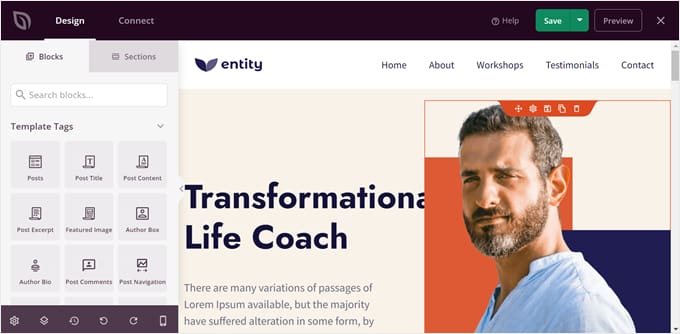
Jeśli nie wiesz od czego zacząć, zapoznaj się z moim przewodnikiem na temat wyboru idealnego motywu WordPress. Zadbaj o czysty i przyjazny dla użytkownika wygląd, a będziesz miał świetny start.
Gdy projekt będzie odpowiedni, możesz rozpocząć tworzenie treści!
Krok 5: Napisanie twojego pierwszego wpisu na blogu ✍️
Kiedy napisałem swój pierwszy post na blogu, nie miałem pojęcia, jak duży będzie miał wpływ. Spędziłem wiele godzin przepisując go, starając się uczynić go idealnym.
Patrząc wstecz, żałuję, że nie skupiłem się tylko na opublikowaniu go. Najważniejszym krokiem jest rozpoczęcie, a WordPress ułatwia zrobienie tego.
Aby napisać swój pierwszy post, przejdź do kokpitu WordPress i kliknij Posty ” Dodaj nowy. Spowoduje to otwarcie edytora, w którym można rozpocząć wpisywanie treści.
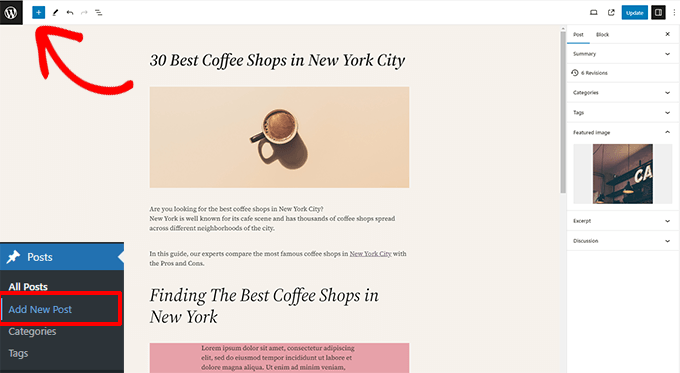
WordPress wykorzystuje edytor blokowy, który pozwala tworzyć 111111 piękne układy dla twoich wpisów. Jest prosty w użyciu i niezwykle elastyczny.
Zapoznaj się z tym kompletnym poradnikiem dotyczącym edytora bloków WordPress, jeśli potrzebujesz pomocy w zapoznaniu się z edytorem.
Po napisaniu twojego wpisu kliknij przycisk “Opublikuj” w prawym górnym rogu. To wszystko – twój wpis na blogu jest już dostępny!

Podczas pisania zauważysz sekcje takie jak Kategorie i Tagi na ekranie postu. Pomagają one w organizowaniu treści. Zalecam przeczytanie naszego przewodnika na temat różnicy między kategoriami i tagami, aby efektywnie z nich korzystać.
Aby w pełni wykorzystać funkcje WordPressa, zapoznaj się z naszym szczegółowym przewodnikiem na temat dodawania nowego posta. Obejmuje on wszystko, od osadzania filmów po dodawanie nagłówków, list wypunktowanych i przycisków wezwania do działania.
Jeśli nie masz pomysłu na swój pierwszy wpis, nie martw się. Wielu nowych blogerów, w tym ja, staje przed tym wyzwaniem. Oto kilka pomocnych zasobów:
- Darmowe narzędzie dogenerowania pomysłów na wpisy na blogu od WPBeginner
- Ponad 130 pomysłów na wpisy na blogu, które pokochają Twoi czytelnicy
- 50 rodzajów tematów blogów, które sprawdzają się w praktyce
- Jak napisać świetny wpis na bloga (struktura + przykłady)
- Jak stworzyć skuteczny plan treści w WordPressie?
Korzystam również z badania słów kluczowych, aby znaleźć jeszcze więcej pomysłów na blog. Pomaga to twojej treści uzyskać wyższą pozycję w wyszukiwarkach i przyciągnąć więcej czytelników. Napisałem przewodnik krok po kroku, jak przeprowadzić badanie słów kluczowych przy użyciu tych samych metod, których używam dla WPBeginner.
Moja rada? Nie dąż do perfekcji w swoim pierwszym poście. Po prostu zacznij pisać i publikuj. Im szybciej zaczniesz, tym szybciej nauczysz się i rozwiniesz jako bloger.
Krok 6: Dodanie niezbędnych wtyczek 🔌
Kiedy po raz pierwszy zacząłem blogować, chciałem, aby moja strona robiła coś więcej niż tylko publikowała posty. Potrzebowałem formularzy kontaktowych, list mailingowych i innych funkcji, które pomogłyby mi zwiększyć grono odbiorców.
W tym miejscu pojawiają się wtyczki. Są one jak aplikacje dla witryny WordPress. Umożliwiają one dodawanie zaawansowanych funkcji do witryny bez konieczności posiadania jakichkolwiek umiejętności technicznych.
Obecnie w katalogu WordPress dostępnych jest ponad 59 000 darmowych wtyczek, więc istnieje wtyczka do wszystkiego, co można sobie wyobrazić. Aby uzyskać szczegółowe informacje, zobacz ten artykuł na temat wtyczek WordPress i ich działania.
Jeśli dopiero zaczynasz przygodę z wtyczkami, nie martw się. Mój zespół stworzył przewodnik krok po kroku, jak zainstalować wtyczkę WordPress.
Przyjrzyjmy się teraz kilku niezbędnym wtyczkom, które powinien mieć każdy blog. Podzielę się moimi osobistymi rekomendacjami w oparciu o to, co sprawdziło się najlepiej dla mnie i moich odbiorców.
Kiedy po raz pierwszy zacząłem pisać bloga, szybko zdałem sobie sprawę, że potrzebuję formularza kontaktowego, aby użytkownicy mogli wysyłać mi pytania, uwagi lub kontaktować się w sprawie możliwości biznesowych. Po wypróbowaniu kilku wtyczek do formularzy kontaktowych, zdecydowałem się na WPForms.
Why I recommend WPForms
- Przyjazny dla początkujących z kreatorem typu “przeciągnij i upuść
- Gotowe szablony oszczędzające czas
- Elastyczne funkcje, które rozwijają się wraz z twoim blogiem
Aby zapoznać się ze szczegółowym opisem wszystkich funkcji, sprawdź moją szczegółową recenzję WPForms.
Ceny: Darmowa wersja Lite | Płatna wersja zaczyna się od 49,50 USD / rok
Zrozumienie odbiorców i śledzenie ruchu na blogu jest bardzo ważne. Używam MonsterInsights, wtyczki nr 1 Google Analytics dla WordPress, do monitorowania ruchu i ulepszania treści mojego bloga.
Why I recommend MonsterInsights
- Przyjazny dla początkujących i łatwy w konfiguracji
- Wyświetla szczegółowe dane analityczne w twoim kokpicie WordPress.
- Śledzi zaawansowane wskaźniki, takie jak wydajność e-handlu i przesyłanie formularzy.
Aby zapoznać się z pełnym zestawieniem funkcji, sprawdź moją szczegółową recenzję MonsterInsights.
Ceny: Darmowa wersja Lite | Płatna wersja zaczyna się od 99,60 USD / rok.
SEO pomaga przyciągnąć ruch do witryny z wyszukiwarek. Używam All in One SEO na wszystkich moich blogach. Jest to najpotężniejszy zestaw narzędzi SEO dla WordPressa na rynku. Jest łatwy w użyciu i nie trzeba być specjalistą SEO, aby z niego korzystać.
Why I recommend All in One SEO
- Przyjazny dla początkujących kreator konfiguracji, który upraszcza SEO
- Narzędzia do map witryn, znaczników schematu i podglądów mediów społecznościowych
- Wbudowane funkcje optymalizacji meta tytułów i opisów
Aby uzyskać pełne zestawienie jego funkcji, zapoznaj się z moją szczegółową recenzją All in One SEO.
Ceny: Darmowa wersja Lite | Płatna wersja zaczyna się od 49,60 USD / rok.
Jedną z najważniejszych lekcji, jakich się nauczyłem, jest zawsze mieć kopię zapasową mojej witryny. Niezależnie od tego, czy przeprowadzasz migrację na nowego hosta, czy też usuwasz problem, kopie zapasowe ratują ci życie. Dlatego polecam Duplicator, potężną wtyczkę WordPress do tworzenia kopii zapasowych / migracji.
Why I recommend Duplicator
- Bezproblemowe tworzenie kopii zapasowych, aby zabezpieczyć twoją witrynę
- Upraszcza przenoszenie twojej witryny na nowego hosta lub domenę.
- Tworzy kompletne archiwa witryny, w tym pliki i bazę danych
Aby uzyskać szczegółowy opis jego funkcji, sprawdź moją szczegółową recenzję Duplicatora.
Ceny: Darmowa wersja Lite | Płatna wersja zaczyna się od 49,50 USD / rok.
Więcej wtyczek i dostosowań WordPressa
Przez lata odkryłem i używałem niezliczonych wtyczek i narzędzi WordPress. Teraz mam sprawdzony i zaufany zestaw narzędzi, których używam na moich blogach.
Oto kilka niezbędnych narzędzi, których używam:
- Bezpieczeństwo – Cloudflare oferuje bezpłatny plan, który zapewnia dodatkową warstwę ochrony bloga. Zalecam również przestrzeganie naszego przewodnika bezpieczeństwa WordPress, aby zabezpieczyć swoją witrynę.
- Wydajność – szybkość ma znaczenie zarówno dla użytkowników, jak i wyszukiwarek. Polecam WP Rocket (premium) lub WP Super Cache (darmowy), aby przyspieszyć twoją witrynę. Mój zespół przygotował kompletny przewodnik po szybkości WordPress z instrukcjami krok po kroku.
- Projektowanie i dostosowywanie – Chcesz tworzyć niestandardowe strony bez pisania kodu? Używam SeedProd i Thrive Architect do projektowania stron docelowych, niestandardowych stron głównych i nie tylko.
- Ruch i subskrybenci – Powiadomienia Push od PushEngage to jedno z moich ulubionych narzędzi do zwiększania ruchu. Jest to obecnie jedno z naszych 5 najlepszych źródeł ruchu na WPBeginner. Postępuj zgodnie z naszym przewodnikiem na temat dodawania powiadomień push.
- E-mail marketing – Budowanie listy mailingowej jest jedną z najmądrzejszych rzeczy, jakie możesz zrobić. Polecam Constant Contact do e-mail marketingu. Aby powiększyć swoją listę, możesz użyć OptinMonster do tworzenia wyskakujących okienek i formularzy o wysokiej konwersji.
Nadal nie wiesz, której wtyczki użyć? Odwiedź Centrum Rozwiązań WPBeginner, gdzie mój zespół i ja wybraliśmy najlepsze wtyczki i narzędzia w oparciu o wieloletnie doświadczenie.
Jeśli jesteś ciekawy wszystkich wtyczek i narzędzi, których używam do prowadzenia WPBeginner, sprawdź mój kompletny zestaw narzędzi WordPress. Zawiera on listę wszystkich narzędzi, które pomogły mi rozwinąć WPBeginner w zasób, którym jest dzisiaj.
Aby uzyskać jeszcze więcej rekomendacji, zobacz mój ekspercki wybór niezbędnych wtyczek WordPress. Narzędzia te sprawią, że twój blog będzie potężniejszy i łatwiejszy w zarządzaniu.
Krok 7: Zwiększanie liczby odbiorców bloga
Jedną z najbardziej satysfakcjonujących części blogowania jest budowanie lojalnej publiczności, która wraca po więcej.
Kiedy założyłem WPBeginner, nie było łatwo zdobyć ruch. Z czasem odkryłem strategie i narzędzia, które zrobiły dużą różnicę.
Oto, jak możesz zwiększyć liczbę odbiorców swojego bloga, korzystając z tych samych metod, których używamy w WPBeginner.
1. Mistrz SEO
Optymalizacja pod kątem wyszukiwarek (SEO) to najlepszy sposób na uzyskanie bezpłatnego ruchu z wyszukiwarek takich jak Google.
Kiedy zaczynałem, nauka SEO szybko stała się jednym z najskuteczniejszych sposobów na rozwój moich blogów. Jednak od tego czasu SEO stało się nieco bardziej skomplikowane.
Wyszukiwarki używają teraz złożonych algorytmów, aby zdecydować, co pokażą w najlepszych wynikach. Niezliczone strony internetowe konkurują ze sobą o miejsca premium.
Aby sobie z tym poradzić, używam All in One SEO for WordPress. Jest to najpotężniejszy zestaw narzędzi SEO dla WordPressa i używam go na wszystkich moich stronach internetowych.
Powiązane: Zobacz, dlaczego przeszedłem z Yoast na All in One SEO (studium przypadku).
Wystarczy zainstalować i aktywować wtyczkę All in One SEO for WordPress, a wyświetli się szybki kreator konfiguracji. Możesz postępować zgodnie z instrukcjami wyświetlanymi na ekranie, a wszystko inne zostanie skonfigurowane za Ciebie.
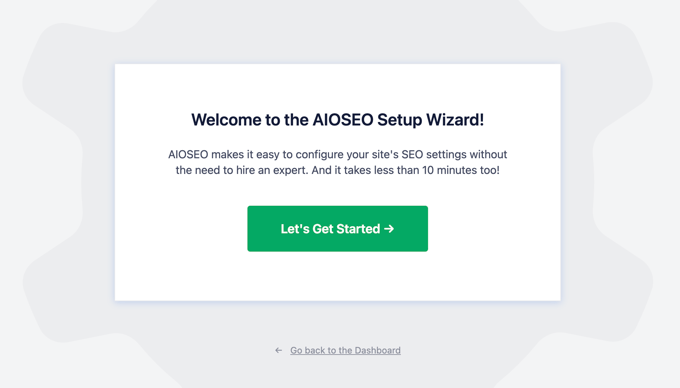
Oferuje zaawansowane funkcje, takie jak meta opisy SEO, konfigurowalne mapy witryn XML, pełną obsługę znaczników schematu, integrację z Google Search Console i wiele innych.
Najbardziej podoba mi się w nim to, że sprawia, że wszystkie te techniczne rzeczy SEO są proste i łatwe. Nie musisz być specjalistą SEO, aby korzystać z którejkolwiek z tych funkcji.
Jeśli dopiero zaczynasz przygodę z SEO, to gorąco polecam zapoznanie się z moim kompletnym przewodnikiem SEO WordPress, w którym krok po kroku pokazałem konfigurację SEO, której używam na wszystkich moich blogach.
2. Zbuduj listę mailingową
Jeśli zapytasz mnie o jeden błąd, którego żałuję, gdy zaczynałem prowadzić bloga, powiedziałbym, że nie zbudowałem od razu listy mailingowej.
W tamtym czasie SEO zdziałało cuda na moich blogach, ale był pewien problem. Użytkownicy, którzy znaleźli mój blog z wyszukiwarek, mogli po prostu go opuścić, a ja nie miałem jak do nich dotrzeć.
To właśnie tam odkryłem, że muszę zacząć budować listę mailingową. Była to najlepsza decyzja, która przyczyniła się do sukcesu wielu moich biznesów, w tym WPBeginner.

Pozwoliło mi to nawiązać bezpośredni kontakt z czytelnikami i przyciągnąć ich z powrotem na bloga. Jeśli poważnie myślisz o zwiększeniu liczby odbiorców, musisz zacząć budować swoją listę już dziś.
Aby rozpocząć, należy zarejestrować się w usłudze e-mail marketingu. Firmy te specjalizują się w wysyłaniu masowych wiadomości e-mail bez uruchamiania filtrów antyspamowych.
Używam Drip na WPBeginner. Oferuje on wiele zaawansowanych funkcji segmentacji odbiorców i personalizacji wiadomości e-mail. Ponadto dobrze współpracuje z innymi narzędziami do marketingu wzrostu, z których korzystam.
Powiązane: Zobacz , dlaczego przeszedłem z MailChimp na Drip (Case Study).
Mimo to, może być nieco zbyt zaawansowany dla początkujących, więc może wolisz używać Constant Contact zamiast tego.
A mówiąc o marketingu wzrostu – nie możesz po prostu dodać samotnego formularza rejestracji e-mail na panelu bocznym twojego bloga, mając nadzieję, że użytkownicy się zarejestrują. Zamierzasz to zrobić mądrze i zapewnić czytelnikom bloga wiele opcji dołączenia do Twojej listy mailingowej.
Najprostszym sposobem na to jest skorzystanie z OptinMonster. Jest to najlepsze oprogramowanie do generowania leadów na rynku, zapewniające potężne narzędzia do przekształcania odwiedzających bloga w subskrybentów.
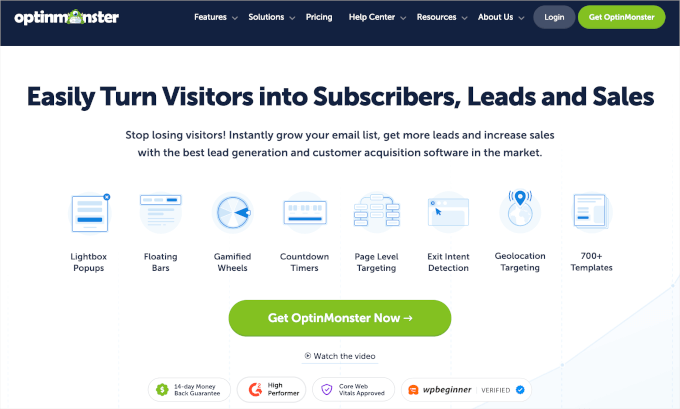
Umożliwia tworzenie pięknych wyskakujących okienek, formularzy typu slide-in, liczników czasu i wielu innych, aby zachęcić użytkowników do dołączenia do twojej listy mailingowej.
Napisałem o wszystkich sprawdzonych metodach, których używam w WPBeginner, aby rozwinąć naszą listę mailingową, więc możesz po prostu skorzystać z mojej strategii.
3. Korzystanie z powiadomień push
Inną techniką, której używam do promowania moich blogów, są “powiadomienia push”. Są to niestandardowe wiadomości, które można wysyłać jako powiadomienia do przeglądarek internetowych klientów na urządzeniach mobilnych i stacjonarnych.

Powiadomienia push to świetny sposób na ponowne zaangażowanie odwiedzających po opuszczeniu witryny.
Aby rozpocząć, musisz zarejestrować się w usłudze powiadomień push. W przypadku WPBeginner korzystam z PushEngage i jest to obecnie jedno z naszych głównych źródeł ruchu.
PushEngage jest bardzo łatwy w konfiguracji i oferuje zaawansowane funkcje, takie jak automatyczne powiadomienia, spersonalizowane wiadomości, odzyskiwanie porzuconych koszyków i niestandardowe formularze optin.
Więcej szczegółów można znaleźć w mojej pełnej recenzji PushEngage.
Mój zespół przygotował również poradnik krok po kroku, jak dodać powiadomienia push w WordPress, który możesz śledzić.
4. Wykorzystanie mediów społecznościowych do budowania społeczności
Platformy mediów społecznościowych są ważnym źródłem ruchu i łatwym sposobem na promowanie nowego bloga.
Jednak w przeciwieństwie do wyszukiwarek, platformy mediów społecznościowych wymagają poświęcenia czasu na budowanie zaangażowania i zasięgu.
Na szczęście istnieją narzędzia takie jak ClickSocial. Umożliwia ono planowanie postów w mediach społecznościowych w WordPress. Wystarczy go skonfigurować, a automatycznie opublikuje zaplanowane treści na profilach w mediach społecznościowych.
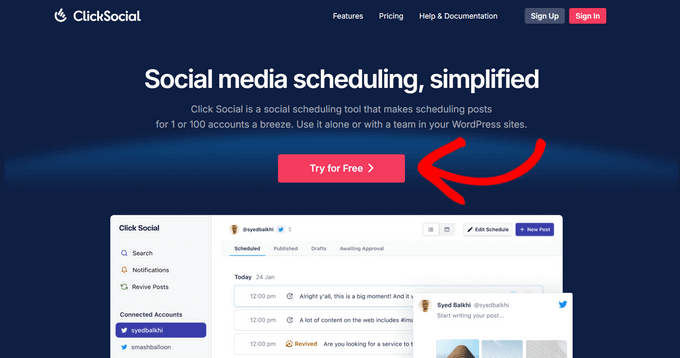
Platformy mediów społecznościowych to jednak ulica dwukierunkowa. Podczas gdy będziesz chciał przyciągnąć użytkowników do swojego bloga, będziesz także chciał zwiększyć liczbę obserwujących na tych platformach.
Jednym ze sposobów na osiągnięcie tego celu jest użycie Smash Balloon. Jest to najpotężniejsza wtyczka do mediów społecznościowych dla WordPressa, która pozwala łatwo osadzać kanały mediów społecznościowych na swojej stronie.

Smash Balloon współpracuje z Facebookiem, Instagramem, X (dawniej Twitter), YouTube i TikTok. Posiada również dodatek do kanału recenzji, który umożliwia wyświetlanie recenzji z Google, Yelp, Facebooka i innych.
Te strategie były głównymi źródłami ruchu na moich blogach. Jednak w miarę pracy nad swoim blogiem znajdziesz inne sposoby na jego promocję i rozwój. Aby uzyskać więcej wskazówek, polecam nasz przewodnik na temat zwiększania ruchu na blogu.
Jedną z lekcji, której nauczyłem się przez lata, jest to, że rozwój wymaga czasu i konsekwencji, więc zachęcam do ciągłego eksperymentowania i uczenia się.
Krok 8: Zarabianie pieniędzy na twoim blogu 💰
Niezależnie od tego, czy prowadzisz bloga w celu generowania pasywnego dochodu, czy po prostu jako hobby, monetyzacja pomaga uczynić go zrównoważonym w dłuższej perspektywie.
Wiele blogów, które zaczynały jako hobby, jest obecnie sześciocyfrowymi firmami, takimi jak Huffington Post, TechCrunch, Mashable i wiele innych.
W WPBeginner używam wielu technik monetyzacji, aby blog był zrównoważony i rozwijał się w pełni.
Oto najlepsze sposoby na zarabianie na blogu w oparciu o strategie, z których osobiście korzystałem i które polecam.
1. Google AdSense
Jednym z najprostszych sposobów zarabiania pieniędzy na blogu jest wyświetlanie reklam. Pamiętam, jak dodałem Google AdSense do jednego z moich wczesnych blogów i stało się to łatwym źródłem pasywnego dochodu.
AdSense działa jako pośrednik, łącząc cię z reklamodawcami, którzy licytują słowa kluczowe związane z twoją treścią.

Jeśli chcesz wypróbować AdSense, to mój zespół ma przewodnik krok po kroku, jak dodać Google AdSense do WordPressa.
2. Marketing afiliacyjny
W artykułach na WPBeginner można zauważyć informację, że otrzymujemy prowizję za kliknięcie w link. Nazywa się to marketingiem afiliacyjnym i jest głównym źródłem dochodu dla wielu blogów.
Polega ona na polecaniu produktów lub usług swoim czytelnikom, a Ty otrzymujesz prowizję, gdy dokonają oni zakupu.
Kiedy założyłem WPBeginner, skupiłem się na promowaniu narzędzi, z których korzystałem i którym osobiście ufałem, co zrobiło ogromną różnicę w budowaniu wiarygodności.
Aby rozpocząć, polecam korzystanie z narzędzi takich jak Pretty Links lub ThirstyAffiliates do zarządzania linkami partnerskimi.
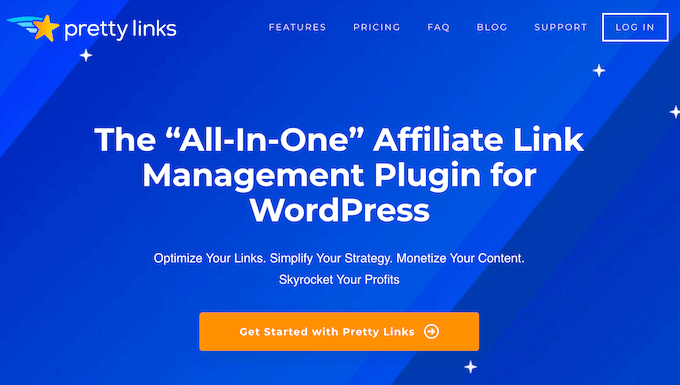
Szczegółowe instrukcje można znaleźć w naszym przewodniku po marketingu afiliacyjnym dla początkujących.
3. Sprzedaż produktów lub usług
Sprzedaż produktów lub usług to kolejny skuteczny sposób na zarabianie pieniędzy. Niezależnie od tego, czy są to produkty fizyczne, cyfrowe pliki do pobrania czy usługi konsultingowe, możesz wykorzystać swój blog do budowania biznesu.
W wielu moich firmach używam Easy Digital Downloads do sprzedaży produktów cyfrowych i WooCommerce do sprzedaży produktów fizycznych.

Jeśli jesteś zainteresowany, zapoznaj się z przewodnikami mojego zespołu na temat zakładania sklepu internetowego i sprzedaży cyfrowych plików do pobrania.
4. Sprzedaż kursów online i subskrypcji
Innym popularnym sposobem zarabiania na blogu jest sprzedaż treści premium lub oferowanie kursów online.
Część treści można umieścić za paywallem dla płatnych subskrybentów. Umożliwia to budowanie społeczności przy jednoczesnym generowaniu wiarygodnych stałych przychodów dla bloga.
Alternatywnie, możesz oferować kursy online za opłatą lub w ramach subskrypcji.
Najprostszym sposobem na to jest MemberPress. Umożliwia on łatwe ograniczanie treści, tworzenie subskrypcji i sprzedaż kursów online.
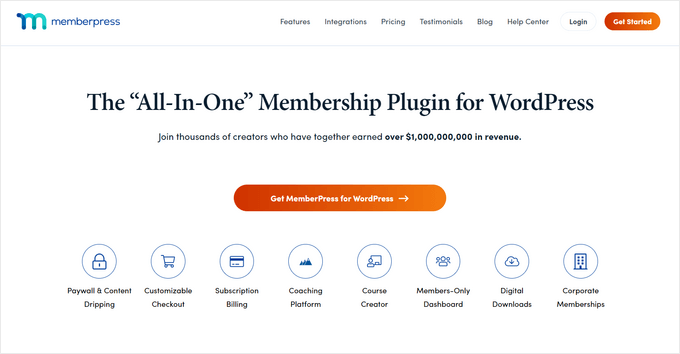
Używam MemberPress na stronie WPBeginner z kursami wideo WordPress. Uważam, że tworzenie kursów, lekcji i quizów oraz zarządzanie subskrypcjami jest niezwykle łatwe.
Aby uzyskać więcej informacji, zobacz moją pełną recenzję MemberPress.
Te strategie pomogły mi przekształcić moje blogi w dobrze prosperujące firmy.
Jeśli chcesz poznać jeszcze więcej sposobów na monetyzację twojego bloga, to przeczytaj ten szczegółowy przewodnik po sposobach zarabiania na blogu. Pamiętaj, że nie ma drogi na skróty – kluczem do sukcesu jest ciężka praca i konsekwencja.
Krok 9: Opanowanie WordPressa
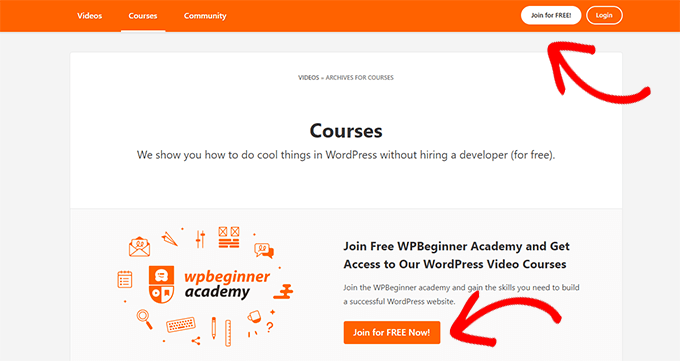
Kiedy zacząłem blogować, było bardzo niewiele zasobów, które pomogłyby początkującym zrozumieć WordPress.
Musiałem nauczyć się wielu rzeczy w trudny sposób, często spędzając godziny na rozwiązywaniu prostych problemów. Właśnie dlatego stworzyłem WPBeginner – aby WordPress był łatwy dla każdego.
Obecnie WPBeginner jest największą darmową witryną z zasobami WordPress dla początkujących. Naszą misją jest wspieranie małych firm, blogerów i nietechnicznych właścicieli stron internetowych za pomocą łatwych do naśladowania poradników i praktycznych wskazówek (zobacz więcej o nas).
Aby poszerzyć swoją wiedzę na temat WordPressa i przenieść swój blog na wyższy poziom, polecam zapoznanie się z tymi zasobami:
- Słownik WPBeginner – Kiedy zaczynałem, często czułem się przytłoczony terminologią WordPress. Dlatego stworzyłem ten przyjazny dla początkujących słownik, aby pomóc ci szybko zrozumieć żargon WordPressa.
- WPBeginner Videos – Nasze darmowe kursy WordPress są idealne dla początkujących. Rozkładamy wszystko krok po kroku, tak jak chciałbym to zrobić, kiedy zaczynałem.
- Blog WPBeginner – Tutaj znajdziesz wszystkie nasze poradniki dotyczące WordPressa, od wskazówek dla początkujących po zaawansowane przewodniki. Jest to moja platforma do dzielenia się spostrzeżeniami i odpowiadania na pytania użytkowników.
Uczenie się od innych jest kluczem do opanowania WordPressa. Zachęcam do dołączenia do naszej bezpłatnej grupy na Facebooku, WPBeginner Engage. Z ponad 98 000 członków jest to fantastyczna społeczność, w której można zadawać pytania, dzielić się pomysłami i nawiązywać kontakty z podobnie myślącymi blogerami i użytkownikami WordPressa.
Warto również zasubskrybować kanał YouTube WPBeginner. Mój zespół regularnie udostępnia tam poradniki wideo, obejmujące wszystko, od podstawowych konfiguracji po zaawansowane dostosowania.
Jedną z najprostszych sztuczek, którą dzielę się z nowymi blogerami, jest korzystanie z Google w celu znalezienia odpowiedzi. Wystarczy wpisać pytanie w Google i dodać przed nim “WPBeginner”. Ta sztuczka pomaga szybko znaleźć nasze przewodniki, oszczędzając czas i frustrację.
Jeśli nadal nie możesz znaleźć odpowiedzi, nie wahaj się skontaktować. Możesz skorzystać z formularza kontaktowego, aby wysłać mi swoje pytanie. Zawsze chętnie służę pomocą.
Wskazówka bonusowa: Poznaj niszowe zasoby dla blogów
Ludzie często pytają mnie o to, jaki temat powinni wybrać dla swojego bloga. Rozumiem, że może być trudno wymyślić, jak wyróżnić się wśród tak wielu innych blogów.
Widziałem wielu nowych blogerów zmieniających branże i tematy na tym samym blogu. Zawężenie tematyki może pomóc w zbudowaniu grupy docelowej od samego początku.
Aby pomóc ci w odkrywaniu różnych nisz, stworzyłem serię przewodników, które pokazują, jak zacząć w różnych popularnych kategoriach blogowania:
- Jak założyć bloga podróżniczego – Podróżowanie zawsze inspirowało ludzi. Jeśli uwielbiasz dzielić się swoimi przygodami, ten przewodnik pomoże Ci przekształcić Twoją pasję do podróży w blog, który łączy się z czytelnikami i przynosi dochody.
- Jak założyć bloga kulinarnego – Kiedy widzę blogi kulinarne, jestem zdumiony, jak jeden przepis może wywołać tak wiele rozmów. Jeśli gotowanie jest twoją pasją, ten przewodnik pokaże ci, jak dzielić się przepisami i zarabiać na swoich umiejętnościach kulinarnych.
- Jak założyć bloga o modzie – Od dzielenia się pomysłami na stroje po budowanie grona entuzjastów mody – ten przewodnik pomoże ci stworzyć bloga w jednej z najmodniejszych nisz.
- Jak założyć blog wideo (vlog) – Treści wideo przeżywają rozkwit, a założenie vloga to skuteczny sposób na nawiązanie kontaktu z odbiorcami. Widziałem blogerów, którzy przekształcili blogi wideo w dobrze prosperujące społeczności.
- Ujawniono: Jakie są najpopularniejsze rodzaje blogów? – Jeśli nie masz pewności, jaką niszę wybrać, ten przewodnik zainspiruje Cię przykładami popularnych i dochodowych kategorii blogów.
- Best Blogging Niches – 7 That Will Make Money (Easily) – Często polecam ten zasób początkującym. Podkreśla nisze, które są nie tylko przyjemne, ale także mają duży potencjał monetyzacji.
Pamiętaj, że zaczynając od niszy nie chodzi tylko o wyróżnienie się – chodzi o zbudowanie społeczności czytelników, którzy ci ufają i wracają po więcej.
Widziałem niezliczoną liczbę blogerów, którzy rozwijali się, koncentrując się na tym, co kochają i dzieląc się tym autentycznie. Zapoznaj się z tymi przewodnikami i zobacz, która nisza jest dla Ciebie odpowiednia.
Często zadawane pytania na temat blogowania (FAQ)
Przez lata odpowiadałem na niezliczone pytania początkujących blogerów, którzy dopiero zaczynają swoją przygodę z blogowaniem. Poniżej znajdują się odpowiedzi na niektóre z najczęściej zadawanych pytań. Mam nadzieję, że pomogą ci one zacząć z pewnością siebie.
Czy mogę założyć bloga bez WordPressa?
Tak, dostępne są inne platformy blogowe. Z mojego doświadczenia wynika jednak, że WordPress jest najlepszym rozwiązaniem. Oferuje niezrównaną swobodę i własność, co ma kluczowe znaczenie dla budowania udanego bloga. Dlatego też zawsze polecam WordPress.
Czy mogę założyć bloga bez hostingu?
Nie, hosting jest niezbędny. Hosting to miejsce, w którym przechowywane są pliki bloga. To jak dom dla Twojego bloga w Internecie. Każdy blog potrzebuje hostingu i nazwy domeny.
Czy założenie bloga na WordPressie jest darmowe?
Samo oprogramowanie WordPress jest bezpłatne, ale trzeba zapłacić za hosting i nazwę domeny. Jeśli masz ograniczony budżet, możesz zacząć od darmowego bloga WordPress.com, ale ma on pewne ograniczenia. Wyjaśniam te różnice w naszym przewodniku na temat ograniczeń WordPress.com i WordPress.com vs WordPress.org.
Jak wymyślić dobrą nazwę bloga dla mojej witryny?
Wiele blogów nosi nazwę swojego twórcy lub tematu, który porusza. Aby uzyskać inspirację, polecam wypróbowanie naszego generatora nazw firm opartego na sztucznej inteligencji. To łatwy sposób na znalezienie kreatywnych i unikalnych pomysłów na nazwy blogów.
Jaka jest najlepsza nisza do blogowania?
Wybór odpowiedniej niszy jest kluczem do wyróżnienia się i utrzymania bloga na rynku. Mój zespół opracował listę najlepszych nisz blogowych i najpopularniejszych typów blogów. Te zasoby mogą pomóc ci wybrać niszę, która jest zgodna z twoimi zainteresowaniami i ma potencjał monetyzacji.
Ile kosztuje założenie bloga?
Koszt zależy od wybranego planu hostingowego i dodatków. Napisaliśmy szczegółowy przewodnik na temat tego, ile kosztuje założenie bloga WordPress, wraz ze wskazówkami, jak zaoszczędzić pieniądze. Większość narzędzi oferuje bezpłatne wersje próbne lub gwarancje zwrotu pieniędzy, dzięki czemu można je wypróbować bez ryzyka.
Czy mogę założyć bloga i zarabiać dzięki Google AdSense?
Absolutnie. Google AdSense to jeden z najpopularniejszych sposobów zarabiania na blogach. Jest łatwy w konfiguracji, a my stworzyliśmy przewodnik, jak dodać Google AdSense do WordPressa.
Czy mogę założyć bloga i pozostać anonimowy?
Tak, jest to możliwe. Możesz użyć pseudonimu, włączyć prywatność WHOIS dla swojej domeny i unikać udostępniania danych osobowych lub zdjęć. Aby uzyskać więcej informacji, zapoznaj się z tym przewodnikiem na temat anonimowego blogowania.
Gdzie mogę znaleźć zdjęcia na bloga?
Wysokiej jakości zdjęcia wzbogacają wpisy na blogu i treści w mediach społecznościowych. Mój zespół opracował listę źródeł bezpłatnych zdjęć stockowych, które można wykorzystać, aby uatrakcyjnić wizualnie swój blog.
Film instruktażowy
Aby uzyskać pełny wizualny przegląd tego, jak założyć bloga, możesz zapoznać się z naszym poradnikiem wideo:
Przemyślenia końcowe
Założenie bloga zmieniło moje życie w sposób, jakiego nigdy sobie nie wyobrażałem. Zaczęło się od małego pomysłu, który przerodził się w coś, co pomogło milionom ludzi na całym świecie.
Jeśli postępowałeś zgodnie z tym przewodnikiem, to zrobiłeś pierwszy krok w kierunku stworzenia czegoś niesamowitego dla siebie. Gratulacje!
Pamiętaj: blogowanie to podróż. Będą wyzwania, ale dzięki konsekwencji, kreatywności i odpowiednim narzędziom możesz zbudować coś naprawdę wpływowego.
Niezależnie od tego, czy Twoim celem jest dzielenie się pasją, nawiązywanie kontaktów z innymi, czy budowanie biznesu, Twój blog może być podstawą niesamowitych możliwości.
Mój zespół i ja w WPBeginner jesteśmy tutaj, aby wspierać Cię na każdym kroku. Jeśli masz jakieś pytania, potrzebujesz wyjaśnień lub opinii na temat swojego bloga, nie wahaj się skontaktować.
Zostaw komentarz poniżej lub skorzystaj z naszej strony kontaktowej. Chętnie się z Tobą skontaktuję!
If you liked this article, then please subscribe to our YouTube Channel for WordPress video tutorials. You can also find us on Twitter and Facebook.

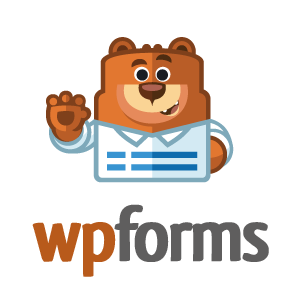


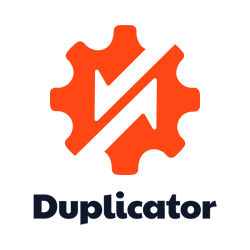
Chris
If a blog require users to login to view certain content, would it be necessary to write code?
WPBeginner Support
No, there are plugins you can use to set that up for you that would allow you to set it up without the need to use code directly
Admin
Hajjalah
I followed this article and successfully created my first blog on WordPress.org. I usually search this website if I face any issues on my blog and thankfully, I am always able to find a detailed article addressing the issues. I am now focusing on growing my website traffic.
WPBeginner Support
Glad to hear our guides are helpful!
Admin
Melody Mbewe
Thank you for this comprehensive beginner’s guide! Starting a WordPress blog can be daunting, but your step-by-step instructions make it approachable for anyone. From choosing the right hosting to customizing themes, this article covers all the essentials. Can’t wait to dive in and start my own blogging journey
Ahmed Moeez
that’s a Really Indepth and Practical guide. thanks, WPBeginner for providing this valuable information.
WPBeginner Comments
Glad that it was helpful!
Nusrath Alam
Hi, Your blog/website is very informative! Thank you!
I’m planning to start a new travel blog, and I have a question – do you recommend that the posts are written directly in the WordPress editor, or is it better to write several posts first in Word or something like that and then copy/paste or import them into WordPress before making it public? What’s the best way?
WPBeginner Support
There is no best way for writing at the moment, it would depend on your personal preference. The main advantage to using the block editor would be less editing your content to match the formatting from another editor.
Admin
Peter Iriogbe
Thanks for the content. But how do I manually use my custom domain and hosting server without buying through Bluehost? I have already installed WordPress on my PC. How do I do that? Please.
WPBeginner Support
It would depend on your specific host, for getting started we would recommend taking a look at our article below:
https://www.wpbeginner.com/beginners-guide/how-to-host-a-website/
Admin
Peter Iriogbe
Thanks for the time you use for putting up these pieces on this page. This is an A-to-Z guide on how to start a blog website and earn money. I recommend beginners follow the step by step mentioned in this article.
My little advice to a starter is not to focus on making money when you are just starting. While making money by blogging is cool, it should not be your main focus because if you do you might lose your commitment when your expectations are not met instead publish content as much as possible and optimize for a better ranking to get more traffic to your site. Afterward, look for ways to start making income from it.
Fajri
Wohoo, surely it is an ultimate guide for anyone who want to start their own blog.
No wonder why wordpress is the best CMS, especially for beginners.
Don’t rush the process in one night, bookmark this page and continue build your website later..
MOINUDDIN WAHEED
While starting out for a new blog the most confusing aspect is the outcome that we see is too much time taken. For years, sratching your head writing articles, posts and getting nothing. I had started a tech blog in 2017 and wrote articles for nearly one year. I couldn’t earn a single penny from that blog and consequently I left it. It seemed all my hardwordk went in vein with no tangible outcome.
Now when I see your posts and go through the minute details, I have a solid opinion now.
It takes time and also a planned practical roadmap. If that roadmap is followed I think it can be turned into full time job. Writing a blog post is tough. Finding a perfect niche is on the tougher side.
Is there a timeline of when our blog will start generating revenue?
WPBeginner Support
There is no specific timeline for when a site will start generating money but for a starting point we would recommend taking a look at our list below:
https://www.wpbeginner.com/beginners-guide/make-money-online/
Admin
Moinuddin Waheed
Thanka for the reply. I have gone through the link and found it to be very useful and practical steps to implement to make money online.
I am implementing all these tips and tricks on my website every passing day and hope to get its benefits one day.
Thanks for the inspiration.
Kabsha Majid
It’s both to-the-point and detailed at the same time. Just an awesome post.
WPBeginner Support
Glad you liked our guide
Admin
vahid fahimi
This was great. I just started and it was really helpful. Thank
WPBeginner Support
You’re welcome!
Admin
Ahmed Omar
This is an extraordinary detailed post about how to start
Thank you very much.
It will take time to go through all the related links
WPBeginner Support
You’re welcome, we hope you find our links helpful!
Admin
tushar
Very Helpful ! Clear all Picture
WPBeginner Support
Glad you found our guide helpful!
Admin
Farhad
How can I create a “community” page where my blog readers can discuss topics raised in my posts?
Thank you.
WPBeginner Support
For what it sounds like you’re looking for, we would recommend taking a look at our article below:
https://www.wpbeginner.com/plugins/how-to-turn-your-wordpress-site-into-a-social-network/
Admin
Dennis Munyao
I have been putting off my decision to own a blog for a long time but after reading your post, i feel ready to venture into blogging now.
WPBeginner Support
Glad we could help give you the confidence to start!
Admin
EMMANUEL
Am planning to start my website creating journey and i come across this site and with all these informations, thanks so much for all these knowledge. i appreciate.
WPBeginner Support
You’re welcome, we’re happy our guides are able to help get you started!
Admin
Jony
thanks a lot i appreciate that a lot
WPBeginner Support
You’re welcome! Glad our guide was helpful!
Admin
shivani singh
Thank you for giving us useful information
WPBeginner Support
You’re welcome!
Admin
Jervice Cj
Thank you, really helpful
WPBeginner Support
You’re welcome, glad to hear our guide was helpful!
Admin
Yogesh Singh
Nice article, but i have a question i am working on a website where i am posting articles everyday so it will be called blog or not because i am not using any wordpress and other platform?
WPBeginner Support
That would depend on the overall organization of your site, for a better understanding of what people mean when they say blog and website we would recommend taking a look at our article below!
https://www.wpbeginner.com/beginners-guide/what-is-a-blog-and-how-is-it-different-from-a-website-explained/
Admin
Brya Hamza
Very helpful
WPBeginner Support
Thank you
Admin
Matt Burn
Great guide this, I am definitely going to be using this when I start my blog properly tomorrow
WPBeginner Support
We hope our guide makes it that much easier for you!
Admin
Manish
Thank you for the information….it’s really useful.
WPBeginner Support
Glad our guide was helpful!
Admin
Nikhil Khunteta
Wonderful!! Thank you for posting the informative blog. Your posts are more interesting and informative.
WPBeginner Support
Glad you found our guide helpful!
Admin
zain ali
I am thinking of starting a blog. Reading this gave me a lot of great information as I am new to this. I plan on reading some of the links you added for more information on various topics. Thank you for having this here!
WPBeginner Support
You’re welcome!
Admin
Musa Rafiq
Thank you for the wonderful tutorial. This really helped me write my own first blog.
WPBeginner Support
You’re welcome, glad to hear our guide was helpful!
Admin
Melissa Millard
Thank you for this post. I am just being introduced to blogging in a course I am taking. We are using WordPress to create blogs. Honestly, I find the whole process a little intimidating. I appreciate you taking the time to walk beginning through the step to create a blog.
WPBeginner Support
Glad you found our guide helpful!
Admin
Khuliso Mashau
What an informative post. Thank you so much. I found this post just at the right time when I was struggling with setting up my WP.
WPBeginner Support
Glad to hear our guide was helpful!
Admin
Chris
Thanks for the super-informative article. I can see from other conversations here that it is possible to have the blog on a separate page within the website – presumably then I can use WordPress to create a whole website with many different features, e.g. a blog, a separate podcast, a page for showcasing my work portfolio, etc.? Would it also be possible to have more than one blog this way, i.e. for different types of content?
Thanks
WPBeginner Support
That can be done and the simplest way to implement it would be to use categories for your content and instead of a posts page, use the category pages for the individual blogs. The category pages work like the posts page but would only list the posts in that specific category.
Admin
Abigail
Thanks for the undiluted information on blogging.
My question is, is it possible to have a blog with two niches?
WPBeginner Support
It is possible to have multiple niches but it will be more difficult to rank well in search engines for multiple niches.
Admin
Farhad
How do I go from Coming Soon stage to have my site accessible on the Internet?
WPBeginner Support
You would normally only have a coming soon page if you have a plugin or tool that is adding that to your site. If you do then you would want to check the settings for the specific plugin you are using on your site.
Admin
Lorin Lopez
Hi, the video showed how to create a blog “post” as well as a separate “page” for my blogs titled “blog” but it didn’t show how to add my posts to that page? Like if I want all my posts to be available on display under the “blog” page on my menu option. is there a way to do that?
thank you!
WPBeginner Support
For that, you would set the blog page under Settings>Reading, for more on how to set this up, you would want to take a look at our article below:
https://www.wpbeginner.com/wp-tutorials/how-to-create-a-separate-page-for-blog-posts-in-wordpress/
Admin
Ivan
Hi,
can I have combination of blog and news aggregator website? I would like to have own posts on the top but some news from other websites below?
WPBeginner Support
You can certainly create a site like that if you wanted
Admin
Gadson
Thank you, this was so informative I am planning to start my own blog and I will use this same knowledge from this platform. But is it possible to create a blog that I can only see myself before paying for the host space. Please advise
WPBeginner Support
To have a local installation of WordPress before you invest in hosting, you would use a program like WAMP or MAMP on your computer. We have a guide on how to install WordPress on your computer below that can guide you:
https://www.wpbeginner.com/how-to-install-wordpress/#installlocal
Admin
Paul Morrison
On a blog site, is there not a way for users to subscribe to be automatically notified of new posts?
WPBeginner Support
To do that, you would normally want to look into using a newsletter. We have a guide on how to set that up below that should help:
https://www.wpbeginner.com/beginners-guide/how-to-create-an-email-newsletter/
Admin
evisionatlanta
I just found you on the right time. This is all I needed to start a blog. The very best informative tutorial I have found. Thank you
WPBeginner Support
Glad our guide was helpful
Admin
Ajoy
Then why is wpbeginner a .com and not a .org .
please let me know . And does the SEO make difference when using an .org or .com
WPBeginner Support
Our domain is .com as that is the most popular type of domain and is one of our recommendations in our guide on choosing a domain below:
https://www.wpbeginner.com/beginners-guide/tips-and-tools-to-pick-the-best-domain-for-your-blog/
If you mean .com in terms of WordPress.com instead of WordPress.org then your domain’s end does not determine if it is a .com or .org site
Admin
Gamaliel
Helo WPBeginnner
Is your blog special still running? The one where I pay for hosting with one of your partners and you build a blog for me
Ameerah
This was really very much helpful. being new to wordpress i felt a little too anxious but after this i am known to everything.
thanks!
WPBeginner Support
Glad you found our guide helpful
Admin
Lisa Keene
Thank for this information. I really enjoyed the blog and made plenty of notes. I hope for them to become useful. Please continue to provide for your readers.
WPBeginner Support
Glad you found our guide helpful
Admin
Sathish S
This is a get to go guide. One of the detailed post that helped me gain more insights and I’m recommending this post to my circle as well.
Keep up the good work.
WPBeginner Support
Glad our guide was helpful
Admin
Muhammad Fahad Zahid
Wow! Thanks for an amazing guide! I have just started my new blog after following the instructions on this post! Hope everything goes right
WPBeginner Support
Glad our guide was helpful and we wish you good luck with your site
Admin
mugie
Thanks for the article @Wpbeginner.
Isn’t it better to build a whole website and only have a section of ‘blog’ as a page for writing your blogs
from what I read it felt like it would almost cost the same to buy a domain name and host a website to having just a blog?
WPBeginner Support
It sounds like you may have some confusion on blogs vs websites, you can see our guide on this in our article below:
https://www.wpbeginner.com/beginners-guide/what-is-a-blog-and-how-is-it-different-from-a-website-explained
Admin
James Kendall
Hello WPBEGINNER SUPPORT..!!
Very nice blog you are created. Highly Appreciate for this.
WPBeginner Support
Glad you like our content
Admin
Michael
I started out my blog 2 weeks after reading this post. It has been so, so, helpful. Bless you!
WPBeginner Support
Glad our guide was helpful
Admin
Mike Crutcher
How can post a “Table Of Contents” or listing of all of my Blog Posts? Can I make them searchable for the reader? I currently can only see recent posts. Should I add another page to my site with a list of the past Blog Posts?
WPBeginner Support
It sounds like you mean a blog page, by default you would have your posts appear on the home page but you can follow our guide below to create a blog page:
https://www.wpbeginner.com/wp-tutorials/how-to-create-a-separate-page-for-blog-posts-in-wordpress/
Admin
Rachel
Hello, if I change my blog domain name after 2 years ,does it affect my ranking though I have very few page visits on my wordpress site
WPBeginner Support
You would want to take a look at a different article of ours linked below:
https://www.wpbeginner.com/wp-tutorials/how-to-properly-move-wordpress-to-a-new-domain-without-losing-seo/
Admin
Michael Adebayo
Can I create a blog without using any page builder such as elementor?
WPBeginner Support
Yes, you can
Admin
Florian Schalk
Hi,
Is there a way to write a blog without logging into the wp-admin?
WPBeginner Support
We do not have a simple method for that at the moment, the closest recommendation would be our guide below:
https://www.wpbeginner.com/wp-tutorials/how-to-allow-users-to-submit-posts-to-your-wordpress-site/
Admin
Richard Dellorfano
I’m a beginner working on the construction of post. I got to the featured image insert, and loaded a media file, but it didn’t show up at the top of my post.
WPBeginner Support
You would likely want to check with the support for your specific theme in case they have a different location for the featured image.
Admin